Intel’s Sandy Bridge i7-2820QM: Upheaval in the Mobile Landscape
by Jarred Walton on January 3, 2011 12:00 AM EST- Posted in
- Laptops
- Intel
- Sandy Bridge
- Compal
Sandy Bridge Graphics: Extended Compatibility and Performance Results
It’s been quite a while since we last looked at gaming compatibility and performance on a large group of titles, so we figured the timing was ripe with the Sandy Bridge launch. We went through and selected fourteen additional games from the past several years; the intention is to see if SNB can run the games properly, as well as what sort of performance it can provide.
For comparison, we selected four other notebooks that we had on hand, which we’ve already highlighted on the previous page. Dell’s Latitude E6410 represents the old guard Intel HD Graphics, and the Toshiba A660D (forced onto the integrated HD 4250 GPU) is AMD’s soon-to-be-replaced IGP. Both are slower than SNB by a large amount, as we’ve already established. On the higher performance side of the equation, we’ve again got the Acer 5551G with a Turion II P520 (2.3GHz dual-core) processor and HD 5650 GPU, and for NVIDIA we have the ASUS N53JF with i5-460M and GT 425M. We tested Low and Medium detail performance, again skipping the Dell and Toshiba systems for Medium.
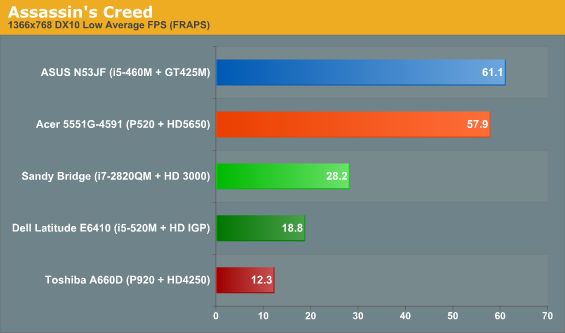

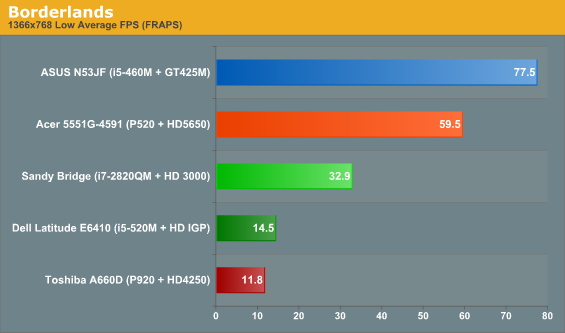
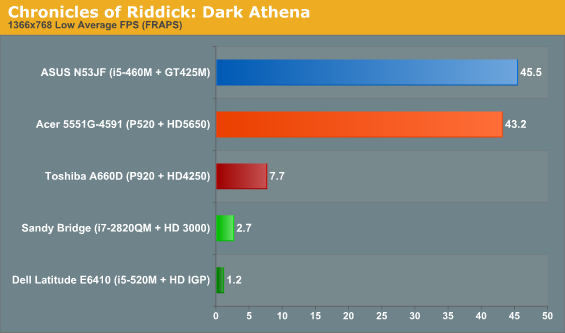

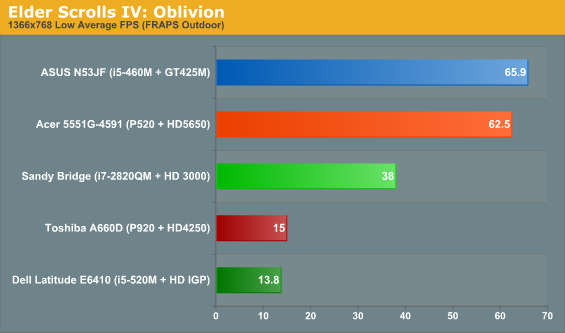
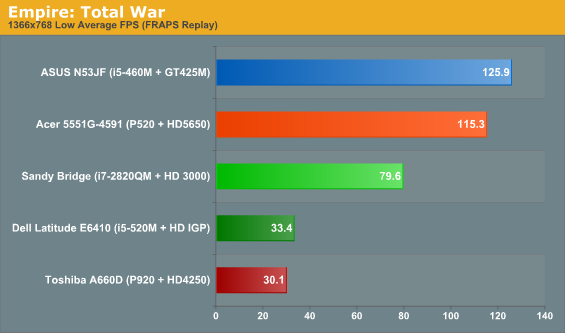
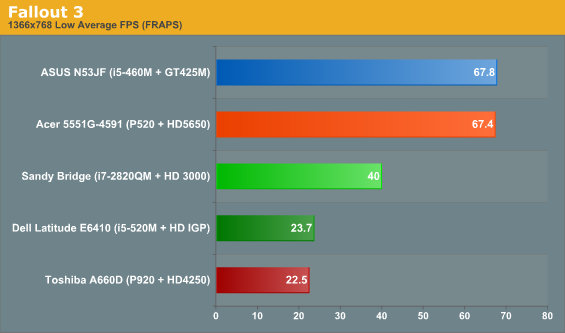
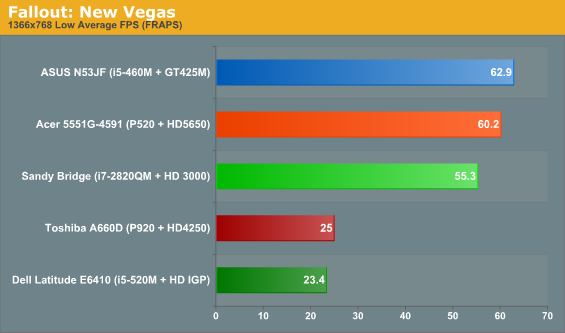
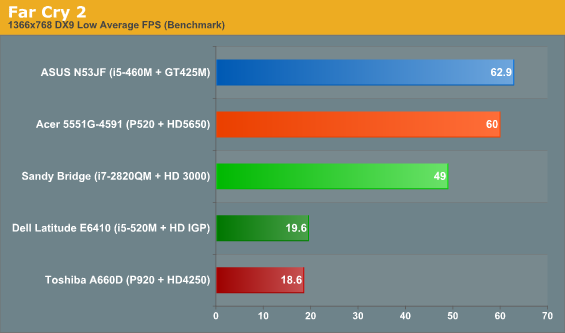
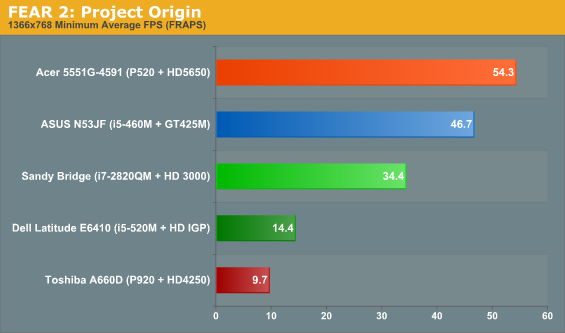

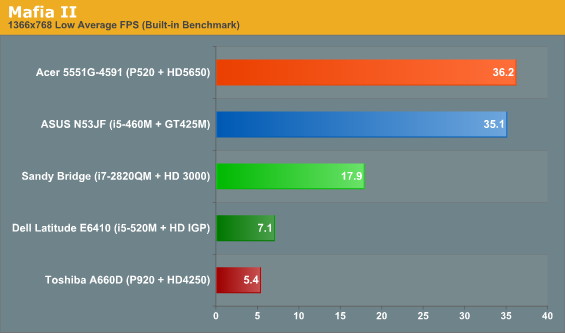
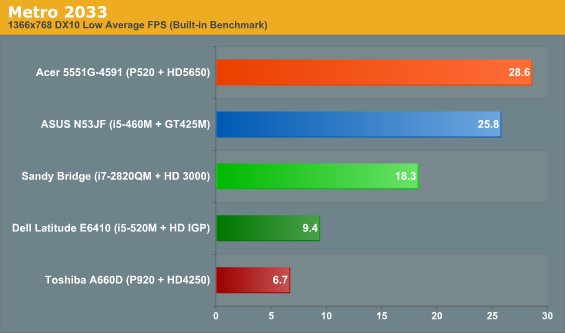
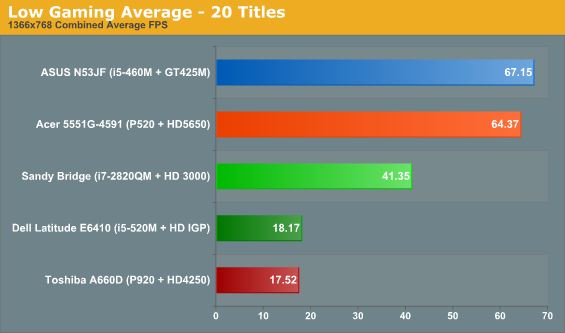
Adding 14 additional titles to the mix exposes a few more areas where Intel’s HD Graphics 3000 chip needs some fine tuning, but again all titles managed to at least run (with a bit of elbow grease). The problem areas run the range of blacklisted titles to minor rendering flaws (sometimes major flaws on older Intel graphics), with one title running but doing so poorly that it may as well have failed the test.
Going into details, first up is the now-infamous Fallout 3, which required a hacked D3D9.dll file to even run (just put the file in the game’s directory—thanks to the creators at OldBlivion). The hacked DLL identifies Intel graphics as a GeForce 7900 GS; without the DLL, the game crashes to the desktop with an error message as soon as you try to enter the actual game world. (Also note that the newer Fallout: New Vegas has no such problems, so Ubisoft was kind enough to stop blacklisting Intel’s IGPs it appears.) There are almost certainly other titles where the Intel IGP is blacklisted, and more than a few games warned of an unknown GPU and potential rendering problems (HAWX 2, Mass Effect 2 and Metro 2033, for instance), but only FO3 required a hack to actually run.
Besides the above, there were some other issues. Assassin’s Creed and HAWX 2 had occasionally flickering polygons, and Mafia II had some rendering issues with shadows; both are minor glitches that don’t render the games unplayable, but in the case of Mafia II performance is too low to be manageable. Finally, the one title from our list that has clear problems with Intel’s current drivers is Chronicles of Riddick: Dark Athena. It’s interesting to note that this is the sole OpenGL title in our suite, and it checks in at a dismal <3FPS. The older Intel HD Graphics on Arrandale has the same issues as HD 3000, with the additional problem of seriously broken rendering in HAWX 2.
Outside of the above problems, performance is typically high enough to handle minimum to medium detail levels. Average frame rates on Sandy Bridge across the 20 test titles ends up at 41FPS. That works out to a 128% improvement over the previous Intel HD Graphics, and a 136% lead over AMD’s HD 4250. The HD 5650 with a slower CPU still leads by over 55%, and GT 425M likewise maintains a comfortable lead of 62%; that said, you can certainly make the case that mainstream gaming is easily achievable with Sandy Bridge. Finally, it’s worth noting that while AMD’s HD 4250 actually ends up slightly slower than the old Intel HD Graphics on average, we didn’t encounter a single noticeable rendering error with that GPU in our test suite.
There are three exceptions to “playability” in our list, counting Dark Athena: both Mafia II and Metro 2033 fail to get above 30FPS, regardless of setting—though Mafia II comes close at 29FPS when set to 800x600. These two titles are a familiar refrain, and it’s worth noting that many discrete mobile GPUs also fail to reach playable performance; in fact, Dark Athena also tends to be a bit too much for anything lower than an HD 5650/GT 420M. They’re the modern equivalent of Crysis, except you can’t even turn down setting enough (without hacking configuration files) to make them run acceptably.










66 Comments
View All Comments
JarredWalton - Monday, January 3, 2011 - link
True, it's been around a while, but I found it interesting that while performance dropped, it wasn't the "slideshow effect". If the system sat idle, the CPU would start to cool down, so when I fired up a benchmark it would run fast for a little bit. It was very perplexing until I figured out what was happening. First run on MediaEspresso gave me 11s with Quick Sync. Then I ran it again and it was 17s. The next time it was suddenly down to 33s.QChronoD - Monday, January 3, 2011 - link
I'm hoping that someone will annouce something like ASUS's new U36JC that has an i5-2410 at CES. I'd love to be able to go a full day at school without needing to recharge in almost every class (and actaully be able to play minecraft between classes)PlasmaBomb - Monday, January 3, 2011 - link
That should read the GTX465 comes next...
PlasmaBomb - Monday, January 3, 2011 - link
To correct the correction (I was going by the graphs), the graphs for the G73J should read GTX460M (I noticed the reference to the GTX460M in the text later and checked the G73J article).God help us all when it comes to talking/writing about the Sandy Bridge chips themselves, "the i7-2539"...
JarredWalton - Monday, January 3, 2011 - link
Fixed, thanks. I had some good ones in those graphs... G73Jw with 260M and 456M, but no 460M! LOLiwodo - Monday, January 3, 2011 - link
now all that is left are Gfx drivers, i hope intel put 10x more resources at their current Gfx Drivers team.Other then that, i am waiting for Ivy Bridge........
ET - Monday, January 3, 2011 - link
I imagine that a single resolution is the best way to compare different machines, but it would have been nice to see some gaming benchmarks at the native res. 1600x900 is not a whole lot higher than 1366x768 (37% more pixels), so I imagine it's possible to game with low details at that resolution. Many Anandtech articles add such figures into the benchmark tables, and I was really missing them here.JarredWalton - Monday, January 3, 2011 - link
I ran out of time, but I did test 1600x900 at our "High" defaults. Umm... not really what you'd want, as everything is completely unplayable. Perhaps post-CES I'll get a chance to do additional testing, but my feeling is most actual notebooks using SNB will likely ship with a 768p display. Some might do 1080p as well, but they'll be more likely to include Optimus GPUs for gaming.therealnickdanger - Tuesday, January 4, 2011 - link
Good idea testing at 1366x768. Not only does it fall in line with most notebook screen resolutions, but it also give good indication of 720p performance. Given that many, many gamers play PS3 and 360 (most games being 720p@30fps), it's very good to see that most games are completely playable from low-medium settings. Some games could probably even get away with higher settings and still stay around 30fps.It's awesome that Intel is putting the "HD 3000" GPU in all its mobile chips, but I'm very curious how the different clock speeds of the GPU and CPUs will affect performance.
ULV Sandy Bridge numbers soon?
therealnickdanger - Tuesday, January 4, 2011 - link
Oh yeah, I forgot to add:What's with Dark Athena? Is it really that stressful to run or is there a driver issue?